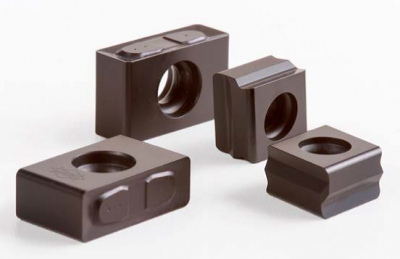
MAPAL offers a broad portfolio of ISO tools for milling operations. A new series of cutting materials has been developed especially for the milling of the whole bandwidth of cast iron grades – GJL, GJV and GJS. Preliminary results show that the new cutting materials allow not only a significant increase in tool life and hence greater cost-effectiveness, but also higher cutting speeds and therefore maximum productivity.
In GJL250, for example, the tool lives have been doubled compared with the cutting materials used to date. The cutting material series is based on newly developed carbide substrates. The structures of the carbides have been modelled in such a way that they provide an optimal relationship between ductility and wear resistance. The carbide grades used are suitable for the ISO field of application K10 to K45. The ductility of the carbides is thereby increased from K10 to K45 by increasing the cobalt content and the particle size of the tungsten carbide.
The cutting material series includes three PVD-coated carbides and two CVD-coated grades. The PVD coating here consists of an optimised TiAlCrN with very fine structuring of the layers to create an optimal relationship between ductility and hardness/wear resistance. The CVD coating is based on an MT-TiCN with alpha-Al2O3 top coat. This layer combination offers not only high wear resistance, but also good thermal stability. A special post-treatment has been developed for both the PVD coating and the CVD coating that ensures an extremely smooth surface and hence an optimal chip flow. This minimises tribochemical wear. With the CVD coating, the post-treatment additionally sets a
selective intrinsic stress in the coating, stabilising the cutting edge or increasing the ductility of the cutting material.
MAPAL can thus offer the optimum cutting material for the milling of cast iron grades for everything from dry to wet machining and for a range of applications and machining conditions.
Contact Details
Related Glossary Terms
- chemical vapor deposition ( CVD)
chemical vapor deposition ( CVD)
High-temperature (1,000° C or higher), atmosphere-controlled process in which a chemical reaction is induced for the purpose of depositing a coating 2µm to 12µm thick on a tool’s surface. See coated tools; PVD, physical vapor deposition.
- ductility
ductility
Ability of a material to be bent, formed or stretched without rupturing. Measured by elongation or reduction of area in a tensile test or by other means.
- gang cutting ( milling)
gang cutting ( milling)
Machining with several cutters mounted on a single arbor, generally for simultaneous cutting.
- milling
milling
Machining operation in which metal or other material is removed by applying power to a rotating cutter. In vertical milling, the cutting tool is mounted vertically on the spindle. In horizontal milling, the cutting tool is mounted horizontally, either directly on the spindle or on an arbor. Horizontal milling is further broken down into conventional milling, where the cutter rotates opposite the direction of feed, or “up” into the workpiece; and climb milling, where the cutter rotates in the direction of feed, or “down” into the workpiece. Milling operations include plane or surface milling, endmilling, facemilling, angle milling, form milling and profiling.
- physical vapor deposition ( PVD)
physical vapor deposition ( PVD)
Tool-coating process performed at low temperature (500° C), compared to chemical vapor deposition (1,000° C). Employs electric field to generate necessary heat for depositing coating on a tool’s surface. See CVD, chemical vapor deposition.
- tungsten carbide ( WC)
tungsten carbide ( WC)
Intermetallic compound consisting of equal parts, by atomic weight, of tungsten and carbon. Sometimes tungsten carbide is used in reference to the cemented tungsten carbide material with cobalt added and/or with titanium carbide or tantalum carbide added. Thus, the tungsten carbide may be used to refer to pure tungsten carbide as well as co-bonded tungsten carbide, which may or may not contain added titanium carbide and/or tantalum carbide.
- wear resistance
wear resistance
Ability of the tool to withstand stresses that cause it to wear during cutting; an attribute linked to alloy composition, base material, thermal conditions, type of tooling and operation and other variables.






